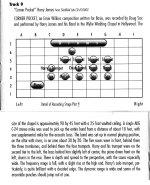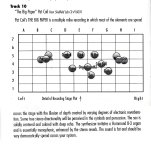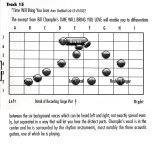I'm not sure what you mean by objective test. The fourth point in your list (the squishy) makes it subjective anyhow. Forgetting that squishy point what's wrong with just recording the soundstage with a mic and using difference analyzing SW when comparing devices? If you think stereo mike and DAT recorder can capture the soundstage what's keeping you from repeating the process at reproduction?swinging back round to imaging again, which in my mind is mainly affected by (in no real order)
-what was encoded on the source.
-speakers
-room interactions (reflection, diffraction, absorbtion etc)
-The wet squishy collection of neurons processing it all
Now I have mentioned many times that a CD I enjoy using for checking all is good with my system (confession it rarely is. Small children and ribbons do not go well together) is Redbird https://en.wikipedia.org/wiki/Redbird_(Redbird_album). This is 4 people, with stringed instruments sitting around a stereo mike with a DAT recorder and apparantly having way too much fun. I love it for the non-musical sounds. The hum of the DAT recorder motor, sound of cars and dogs outside. It's as pure a recording as you get outside bluegrass BUT what should the soundstage be? Should 2 singers be behind you, or one sitting on top of the other? That part I can't work out, despite you being almost able to guess where the window is in the living room they were recording in. What I do know is that if one of the singers is coming from outside the speakers something must be wrong as they weren't sitting that far apart! Not sure collectively we have enough recordings where we know what it should sound like as references so are left guessing, and possibly guessing wrong.
So to the question. If someone were to come up with a suitable recording where the captured soundstage were known and people could map out what they heard where then compare with what they should get for a figure of imaging merit, would that be an objective test... And no AudioPrecision equipment involved!
Sorry, I didn’t get what you meant with “repeating the process at reproduction”, repeating what process ?
Hans
Hans
If stereo mike and DAT recorder can accurately capture the soundstage at recording stage why not re-record the soundstage at reproduction stage.
This was meant for those claiming to hear differences in soundstage between devices.
This was meant for those claiming to hear differences in soundstage between devices.
See I would love something like that as a locked track on a classical music CD where someone is walking around the stage calling out where they are as a reference. I used to get very confused listening to some of the mercury living presence recordings until I discovered the orchestra layout was done differently in those days!Nature recordists attempt this when experimenting with mic arrays, walking circumferences in regular intervals calling out degrees.
And yes I know I should see someone about that...
Bill, at the riskof confusing things... 🙂
https://www.soundonsound.com/forum/viewtopic.php?f=16&t=67688
https://www.cambridge-mt.com/
George
https://www.soundonsound.com/forum/viewtopic.php?f=16&t=67688
https://www.cambridge-mt.com/
George
Bill,
Is this something in the direction you are looking for ?
https://www.dropbox.com/scl/fi/1k5d...Sfm6.zip?rlkey=3u6ewtvvswh7dsdrads6kywrm&dl=0
Hans
Is this something in the direction you are looking for ?
https://www.dropbox.com/scl/fi/1k5d...Sfm6.zip?rlkey=3u6ewtvvswh7dsdrads6kywrm&dl=0
Hans
George, you never confuse things. I know classical mike techniques vary from just 2 channels to whole trees. I think the BBC fly around 60 microphones for the proms each year as they need to do stereo and TV surround mixes for many types of music, but they never say what the final soundfield is supposed to be!
I totally agree with this, but the brain is already calibrated to its own evolutionary "standard".We have the most powerful Signal processor between our ears unfortunately we have no way to calibrate it to a standard. So we try to come up with a measurement process to compare, however out technology has not reached a point that truly engulfs the listening experience.
Put two healthy and cultured people under the exact same conditions to listen to the same system and the same track and they will hear the same thing.
@Hans Polak that looks really useful, but what does 'the sound is fat and should be democratically spread' mean?
Agreed, and having fun is the most important thing. 😍But it can still be very enjoyable
dave
It is the search for the absolute - that does not exist - that creates so many useless conflicts.
On the path of science we should adopt humble, not arrogant attitudes, otherwise we never learn.
And they (the arrogant) are the same that only want to pretend to teach! 😉
Learning can sometimes be painful. We all live in our own reality tunnels to some degree and it can be a major undertaking to break through. We can sometimes be like the dung beetle, rolling a big ball of what we think is true around until it’s bigger than we are.
Last edited:
You are the real artist with words, so when you don’t even understand, don’t ask me 🤣@Hans Polak that looks really useful, but what does 'the sound is fat and should be democratically spread' mean?
As a matter of fact, if you like I could send these tracks via a Dropbox link, as I did with the previous Stereophile track.
Just let me know.
Hans
Yes it is Dave…….but the landscape is changing fast. The death of the retail record company business had unintended consequence…..the loss of artistic and cutting edge production. Now we’re all left bathing in a sea of redundant, meaningless content that’s consumed like popcorn……..nobody ever looks or eats a single kernel…..they just inhale the stuff for a chew…..something to alleviate the boredom and momentary hunger.But it can still be very enjoyable
dave
As true as it is simply human.Learning can sometimes be painful.
In one way or another the average human experiences are similar, subject to the necessary and obvious exceptions for better or for worse.
What really changes is in the qualities of the single people.
There are the humble and the arrogant.
The wise men and the braggarts.
The greedy and the balanced.
And all the different and related consequences.
IMO
Possible, but please note the fact is that for the "dung beetle", doing what it does has its absolute dignity: there is no bad and no good in what it does.We can sometimes be like the dung beetle, rolling a big ball of what we think is true around until it’s bigger than we are.
The issue arises if/when personal interests come into play because then there are those who in that case people do not collaborate, but rather deliberately sabotage.
It also depends on what other qualities they have.
IMO
I very much doubt this thesis.Put two healthy and cultured people under the exact same conditions to listen to the same system and the same track and they will hear the same thing.
Even assuming the unlikely probability that all their hearing sensors (not only ears but also other pressure sensitive parts of the body) are transmitting the same info to their brains, but how and to what result their brains are processing this all is highly unlikely the same, already given the simple fact that no two brains are physically the same.
Hans
Actually rather than confused I am intrigued by some comments in there on the accent mics they talk about left-right panning but nothing about adjusting for depth illusion, which infers from a sample of one forum they don't consider it a problem.Bill, at the riskof confusing things... 🙂
https://www.soundonsound.com/forum/viewtopic.php?f=16&t=67688
I'm going on the hunt for that sheffield labs CD for my collection!As a matter of fact, if you like I could send these tracks via a Dropbox link, as I did with the previous Stereophile track.
Just let me know.
This discussion is making me want to start playing with mid-side processing for stereo width control.
Then you have just created an absolute dead-end mathematical condition with no way out.already given the simple fact that no two brains are physically the same.
So why to continue?
No, you’ll have a shared experience…..nothing more. Subtle variance in the shape of the outer ear will place individual frequencies in different places in a 3D space. The differences in our posture and reflections from our shoulders to our ears including variances in our clothing will do the same. In the moment physical state such as PB, heart rate, fatigue and in the moment temperament will also induce different responses to stimuli. Yes, as individual variance, each is subtle…..but when combined (as they often are) can be profound IF the listener is focused and attentive to the task.I totally agree with this, but the brain is already calibrated to its own evolutionary "standard".
Put two healthy and cultured people under the exact same conditions to listen to the same system and the same track and they will hear the same thing.
And let’s not forget the room…..shared experience comparisons in different 3D spaces is a complete and utter waste of effort.…..visit a professional studio mixdown or mastering control room and you’ll understand why.…… 90% of the folks who have dedicated 2 channel systems are better off with a good set of headphones.
- Status
- Not open for further replies.
- Home
- Member Areas
- The Lounge
- Why the objectivists will never win!


